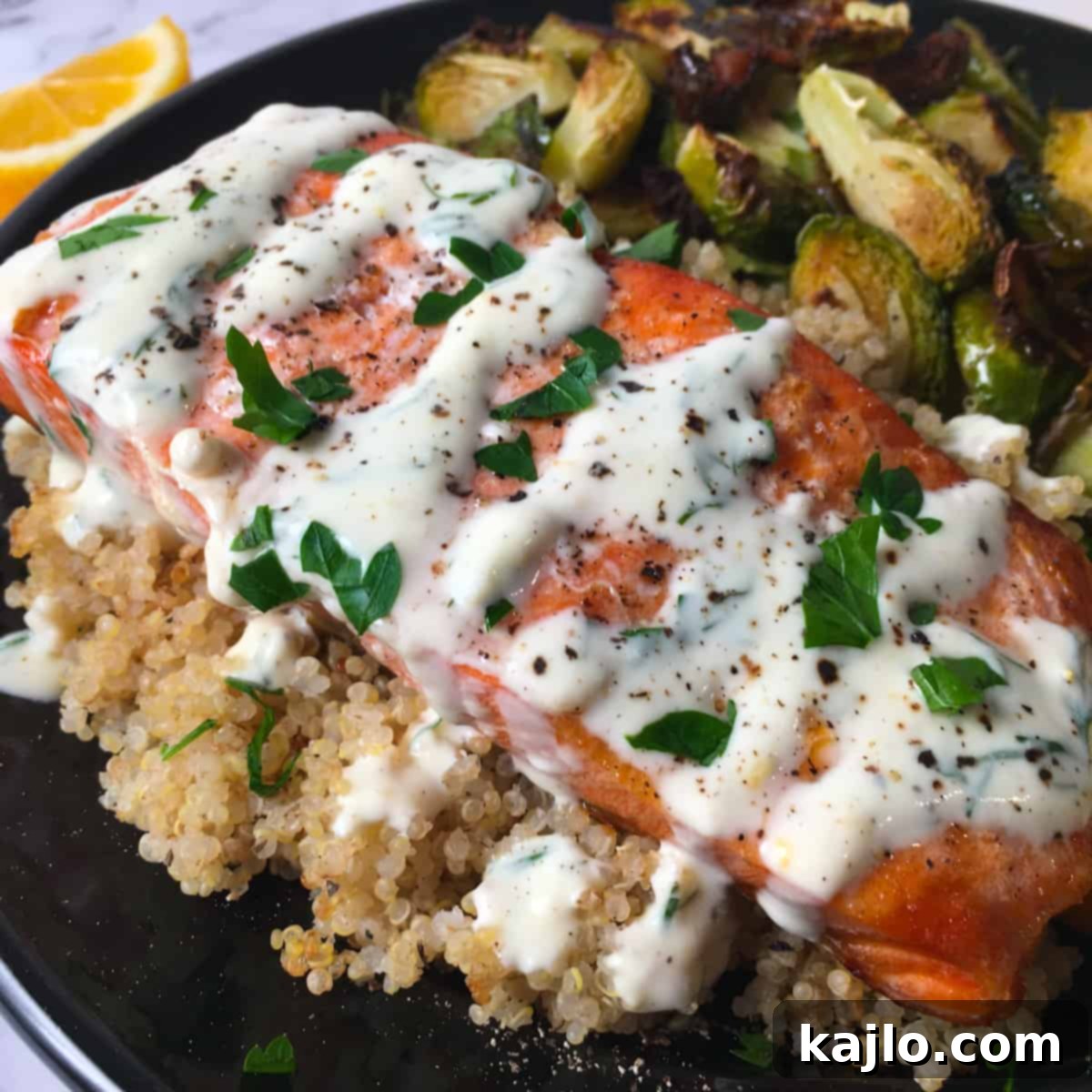Air Fryer Frozen Salmon: A Quick & Healthy Meal Solution
Are you looking for a hassle-free way to cook delicious, healthy salmon? The answer is a resounding yes! You absolutely can cook frozen salmon directly in your air fryer, eliminating the need for tedious thawing. This comprehensive guide will teach you how to prepare perfectly flaky air fryer frozen salmon fillets, complemented by an indulgent yet low-carb, keto-friendly, and gluten-free lemon cream sauce. This easy weeknight dinner idea boasts just 2.2 grams of net carbs per serving, making it an ideal choice for health-conscious foodies. We’ll cover instructions for both air fryer and oven methods, ensuring you can enjoy this versatile dish whether your salmon is fresh or frozen.
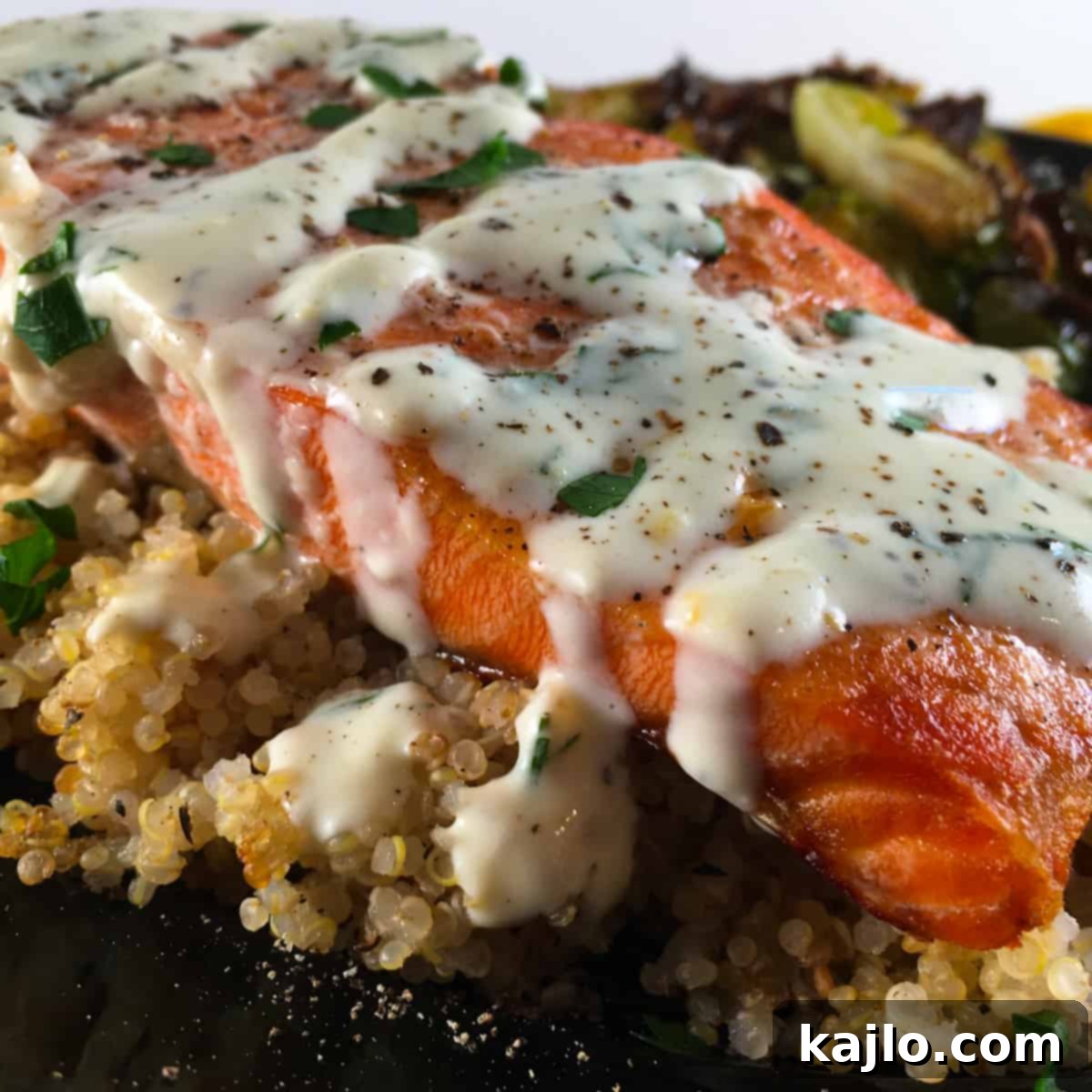
Discovering that you can cook salmon directly from the freezer in an air fryer is a game-changer for busy weeknights. This simple culinary hack significantly streamlines meal preparation, allowing you to enjoy a nutritious and flavorful dinner without the usual planning ahead. Forget about remembering to defrost your protein; simply grab your frozen salmon and let the air fryer do the work.
The result of cooking air fryer salmon from frozen is consistently impressive: tender, moist, and flaky fish every time. Just like fresh salmon, you’ll be treated to a rich source of healthy omega-3 fatty acids, crucial for heart and brain health. For maximum health benefits and to help prevent the fish from drying out, it’s recommended to air fry frozen salmon with skin on.
Beyond convenience, opting for frozen salmon can also be a smart financial decision. Fresh salmon steaks can often be quite expensive, whereas high-quality frozen salmon fillets are readily available at more budget-friendly prices from stores like Aldi, Costco, Trader Joe’s, or Sam’s Club (Member’s Mark). This makes a healthy seafood dinner more accessible and affordable for everyone.
Interestingly, the thinner (and typically less expensive) frozen salmon fillets actually perform best in this air fryer recipe. This is excellent news for both your wallet and your taste buds! Salmon is notoriously easy to overcook, and this risk is even higher with frozen varieties. However, with our expert tips, you’ll be able to air fry frozen salmon steak (or rather, fillet!) to absolute perfection, achieving an ideal texture and flavor.
And should you happen to slightly overcook your salmon, don’t fret! Our rich and tangy lemon cream sauce is incredibly forgiving, doing a wonderful job of moistening any dry spots and ensuring your meal is still incredibly delicious. Your secret is safe with us.
⭐ Why Air Fry Frozen Salmon? Unlocking the Benefits
What makes salmon cooked in the air fryer such a fantastic choice? Here are compelling reasons to make this easy seafood recipe a staple in your kitchen:
- Rich in Heart-Healthy Omega-3 Fats: Salmon is an oily fish renowned for its exceptional omega-3 fatty acid content. These essential fats are known for their powerful anti-inflammatory properties, promoting cardiovascular health and supporting optimal brain function. Incorporating salmon into your diet regularly is a delicious way to boost your intake of these vital nutrients.
- Excellent Source of High-Quality Protein: Seafood, especially salmon, is an outstanding source of complete protein, which is essential for muscle repair, growth, and overall bodily functions. While salmon is a fatty fish, meaning it’s not a lean protein in the traditional sense, its fat content comes primarily from beneficial unsaturated fats, making it a highly nutritious protein choice.
- Dietary Versatility: This air-fried salmon recipe, prepared without breading, is incredibly versatile and accommodating for various dietary preferences. It’s a perfect fit for gluten-free, low-carb, keto, pescatarian, and Weight Watchers (WW) diets. Simply adjust your chosen side dishes to align with your specific dietary needs and health goals.
- Energy and Time Efficient Cooking: The air fryer offers a remarkably quick cooking method. You can cook frozen salmon in roughly the same amount of time it takes to preheat a conventional oven, or even less! This makes it an energy-saving choice, especially during warmer months when you want to avoid heating up your entire kitchen.
- Consistently Perfect Results: One of the often-overlooked advantages of air fryers is their automatic shut-off feature after the set cooking time. This built-in safety measure means that even if you get momentarily distracted (which happens to the best of us!), your fish won’t continue to cook and risk becoming overdone and dry.
- Unmatched Convenience: The ability to cook salmon directly from frozen is a huge time-saver and a blessing for anyone with a busy schedule. If you frequently forget to thaw dinner before heading out for the day, this recipe eliminates that planning hurdle, making healthy eating more achievable.
- Irresistibly Delicious: Salmon’s naturally rich, buttery flavor makes it a favorite among fish lovers. When paired with our luscious lemon cream sauce, this dish transcends ordinary weeknight meals, offering a gourmet experience that will impress.
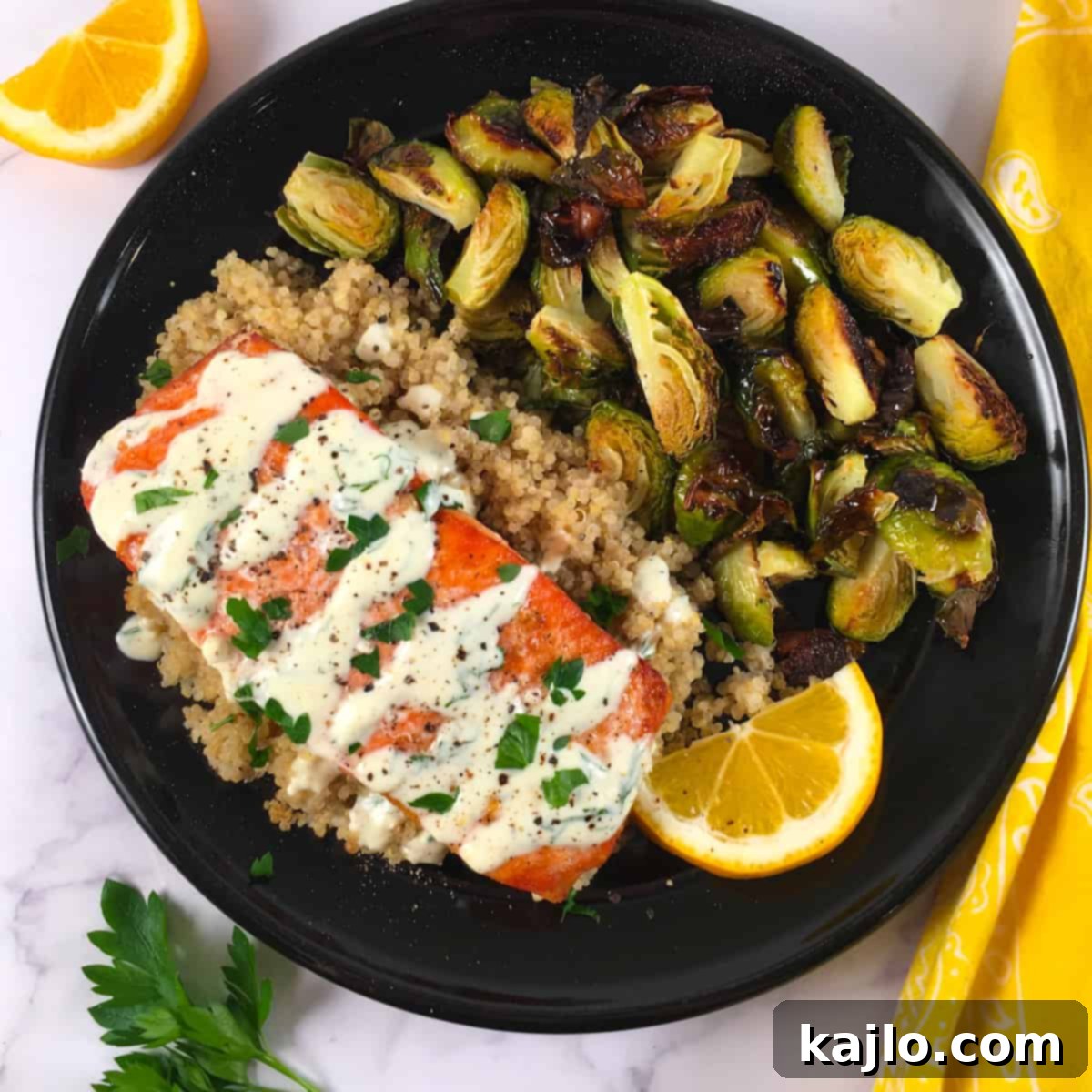
🥘 Essential Ingredients for Air Fryer Frozen Salmon
To create these delectable frozen salmon fillets in an air fryer, you’ll need a few key components:
- 12 ounces of frozen salmon (typically two skin-on fillets)
- Cooking oil spray
- Olive oil
It’s important to clarify the distinction between “salmon steaks” and “salmon fillets,” as the terms are often used interchangeably but refer to different cuts. According to culinary definitions, salmon steaks are typically cut perpendicular to the spine and often contain bones. Salmon fillets, on the other hand, are cut parallel to the spine and contain minimal to no bones. For this specific recipe, boneless salmon fillets are preferred for easier eating and more consistent cooking.
When selecting your salmon, aim for fillets that have a uniform thickness across the entire piece. This consistency is crucial for even cooking, preventing thinner edges from drying out while the thicker center cooks through. Save your more expensive, thicker salmon steaks for fresh cooking methods where their characteristics can be better appreciated. For air frying, thinner fillets truly yield superior results.
A crucial air frying tip for this recipe is to opt for thin salmon fillets. The ideal thickness is around ½-inch (1.27 cm) at the thickest point. Thicker cuts of salmon will naturally require a longer cooking time. This extended cooking increases the likelihood of the edges becoming dry before the center reaches a safe internal temperature. Moreover, thicker cuts tend to be more expensive, making thin fillets a smart choice for both culinary results and budget.
Keeping the skin on your salmon fillets serves multiple purposes: it reduces food waste, adds a beautiful crisp texture when cooked properly, and significantly boosts the healthy fat content of your meal. When purchasing fresh fish, a pleasant, clean scent (or no scent at all) indicates freshness. Frozen salmon, by nature, should have virtually no detectable odor.
For ease of preparation when cooking frozen salmon in the air fryer, we highly recommend using individually wrapped frozen salmon fillets. This thoughtful packaging prevents the fillets from freezing together in a solid block, eliminating the frustration of trying to pry them apart before cooking. This simple step can save you valuable time and effort in the kitchen.
Both farmed salmon and wild-caught salmon are suitable for this recipe. While wild-caught Alaskan salmon is often favored for its robust flavor and often higher omega-3 content, your personal preferences and grocery budget should ultimately guide your choice. The most important thing is to choose salmon that is accessible and affordable for you, ensuring that you can regularly enjoy this nutritious fish without undue financial strain.
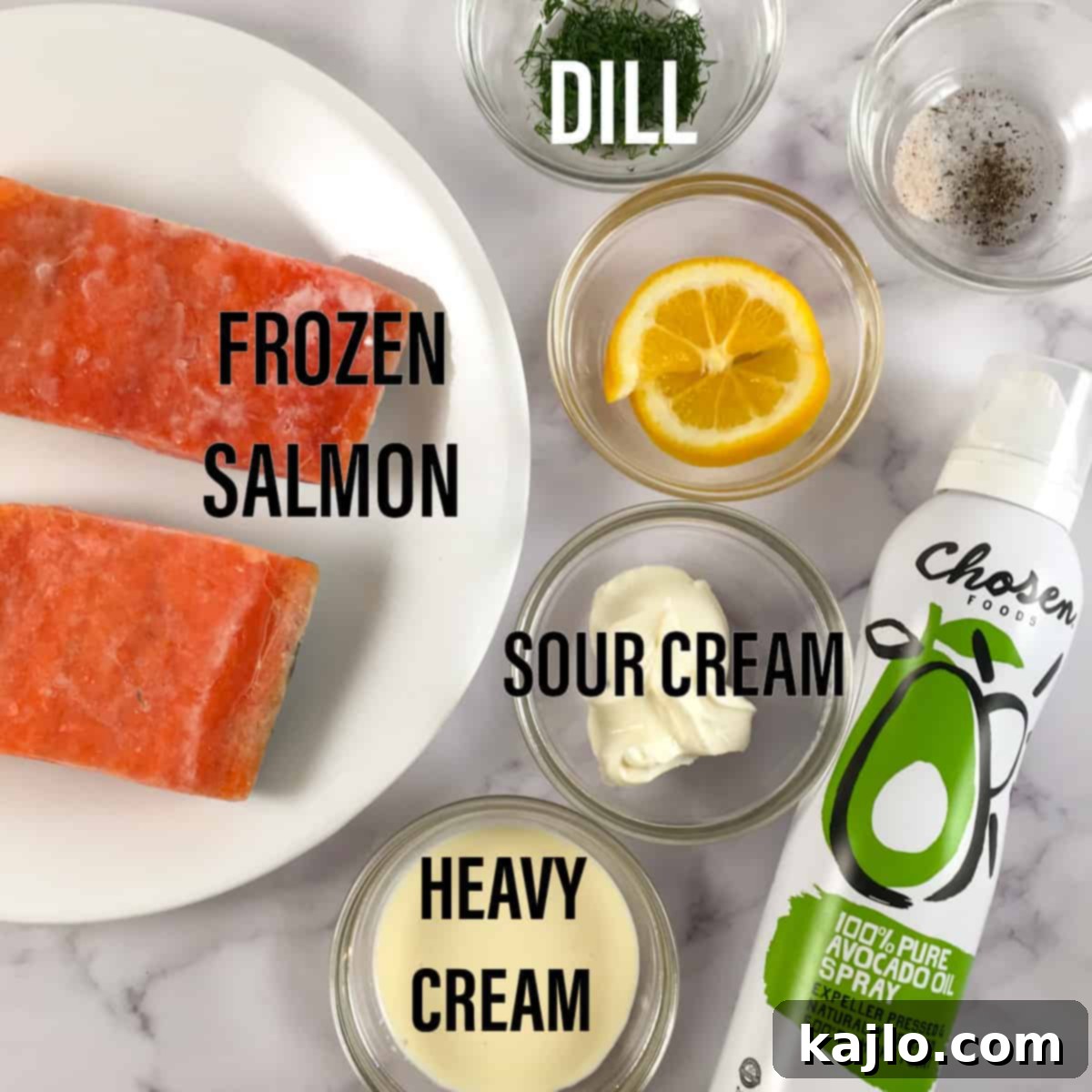
🍋 The Zesty Lemon Cream Sauce for Salmon
This recipe isn’t complete without its bright and creamy lemon sauce, which beautifully complements the rich flavor of the salmon. The best part? You can easily whisk it together on the stovetop while your frozen salmon is air frying. Here’s what you’ll need to create this delightful accompaniment:
- Heavy cream
- Sour cream
- Fresh lemon zest
- Fresh lemon juice
- Finely chopped fresh dill
- Salt and pepper, to taste
For the most vibrant and authentic flavor, we highly recommend using freshly squeezed lemon juice for the sauce, rather than bottled varieties. If you can find them, Meyer lemons will provide an extra special boost of sweet and floral citrus flavor that truly elevates the sauce.
🍽 Essential Equipment for Success
To master this air fryer salmon recipe, you’ll need a few basic kitchen tools: a reliable meat thermometer to ensure food safety, a silicone pastry brush for even oil application, and, of course, an air fryer. For the lemon cream sauce, you’ll need a small saucepan, a whisk, a microplane for zesting, and a manual juicer for your fresh lemons.
Important Note on Air Fryer Models: This recipe is adaptable for a wide range of air fryer brands and models, including popular ones like Ninja Foodi, Cosori, Pampered Chef Air Fryer, Actifry, Nuwave, Instant Vortex, Cuisinart, Philips, and Power Air Fryer. However, it’s crucial to understand that cooking times and temperatures can vary significantly between different models. Always monitor your food closely the very first time you try a new air fryer recipe. What works perfectly in one air fryer might require adjustment in another.
In our experience, following the exact air frying times specified in many common recipes can sometimes lead to undercooked fish. Conversely, it’s also easy to overcook fish. Therefore, it’s essential to adjust cooking times as needed and always confirm the doneness of your salmon with a meat thermometer, aiming for the safe internal temperature of 145°F (63°C).
🔪 Step-by-Step: How to Make Frozen Salmon in Your Air Fryer
Let’s begin cooking how to cook frozen salmon in an air fryer! Start by preheating your air fryer to 390 degrees Fahrenheit (199°C) for a full 5 minutes. Proper preheating is key to achieving a crispy exterior and even cooking.
Carefully spray a hot air fryer tray or basket with cooking oil spray. Place the frozen salmon fillets onto the tray, ensuring the skin side is facing down. Using your pastry brush, evenly brush the tops of the salmon fillets with half of the olive oil. Position the tray with the salmon in the top rack of your air fryer. It’s now ready for its initial air frying phase!
️⏲ Air Fryer Frozen Salmon Cooking Time and Temperature: Achieving Perfection
Cook the frozen salmon in your preheated air fryer for a total of 14-16 minutes at 390 degrees Fahrenheit (199°C). It is essential to flip the salmon about halfway through the cooking time, after approximately 8 minutes, and brush it with the remaining olive oil. This ensures even cooking and helps the skin develop a delightful crispness.
The crucial indicator of doneness for seafood is its internal temperature. Always check your salmon fillets after air frying to ensure they have reached a safe minimum internal temperature of 145°F (63°C). This temperature guarantees food safety while maintaining optimal texture.
As previously mentioned, if you choose to use a thicker salmon steak (approximately 1-1.5 inches or 2.54-3.8 cm thick) in this recipe, you risk the outer edges drying out significantly before the thickest part reaches the safe internal temperature. To ensure a moist and perfectly cooked result without wasted effort or expense, remember our recommendation: always opt for thinner salmon fillets for this air fryer method.
While your salmon is cooking in the air fryer, it’s the perfect time to prepare the luscious lemon cream sauce. In a small saucepan, combine the heavy cream, sour cream, fresh lemon zest, fresh lemon juice, salt, and pepper. Whisk these ingredients together gently over medium heat until the mixture is smooth and just heated through. Avoid bringing the sauce to a boil; you simply want the sour cream to fully incorporate and melt into a creamy consistency. Once smooth and warm, remove the saucepan from the heat, whisk in the finely chopped fresh dill, and set the sauce aside to keep warm. Once the salmon is cooked, generously drizzle this exquisite sauce over the top, transforming a simple dish into a culinary delight.
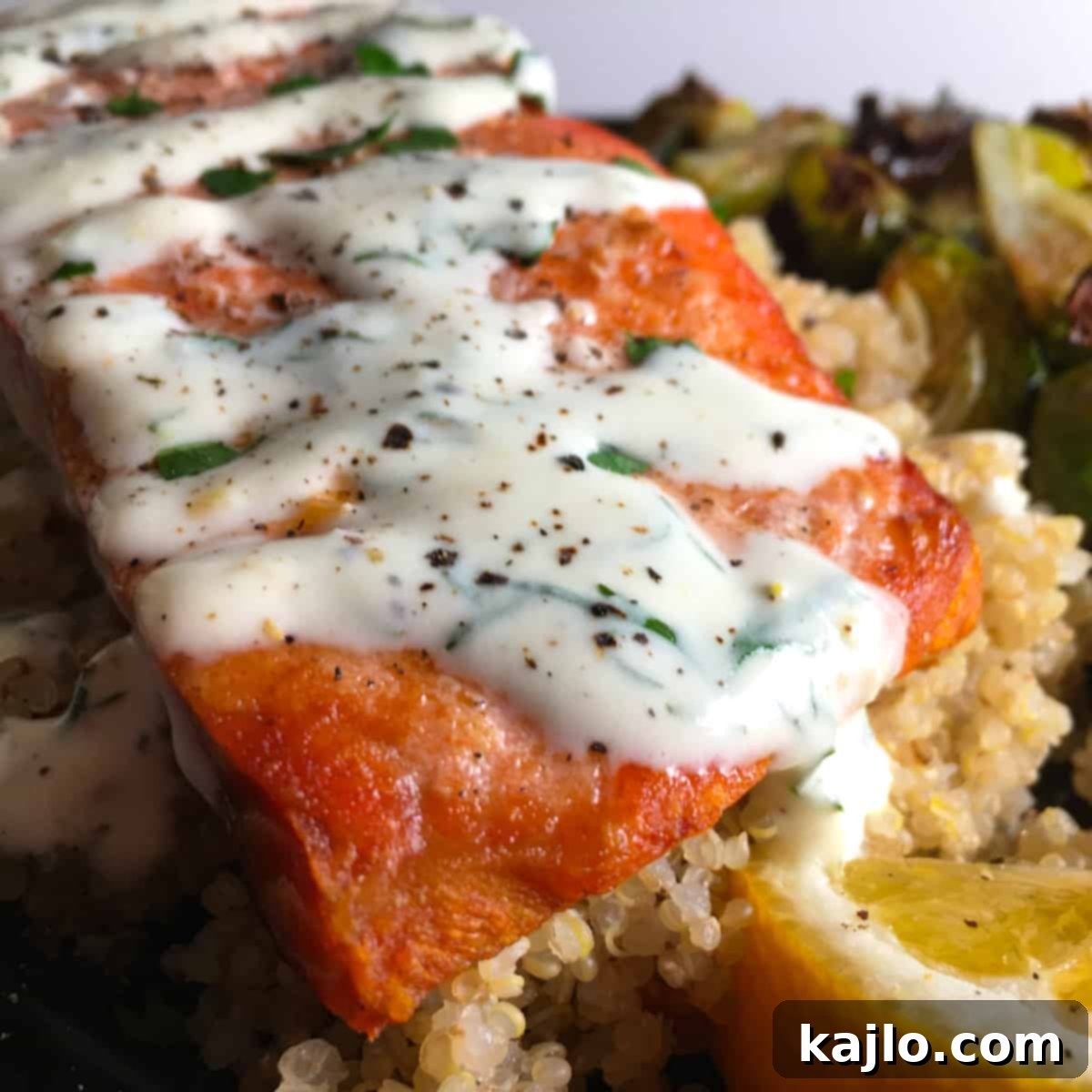
🔥 Alternative Cooking Method: Oven Baking Fresh Salmon
While this article focuses on the convenience of air frying frozen salmon, you can certainly achieve delicious results by baking fresh salmon fillets in a conventional oven. To do so, preheat your oven to 400°F (200°C). Place the fresh salmon fillets on a metal baking pan. Bake for approximately 10 minutes, or until the salmon reaches the safe minimum internal temperature of 145°F (63°C). Always use a meat thermometer to verify doneness, and extend the cooking time if necessary. Prepare the lemon cream sauce as directed above and drizzle over the oven-baked salmon for a flavorful meal.
️🌡️ Maximizing Your Meal: Smart Storage & Reheating Tips
How long does cooked salmon last? According to the USDA, cooked salmon can be safely stored in the refrigerator for up to 3-4 days. However, for optimal taste and texture, we recommend consuming any leftovers within 48 hours. Proper storage in an airtight container will help maintain its freshness.
Fortunately, cooked salmon is incredibly versatile and easy to repurpose, especially if stored separately from the sauce. To reheat, gently warm the salmon in the microwave or on the stovetop over low heat. Transform your leftovers into exciting new meals: flake the salmon for delicious fish tacos, create a vibrant salmon salad, or build a satisfying salmon rice bowl. The possibilities are endless!
It is safe to refreeze previously frozen salmon that has been thawed or cooked. However, be aware that repeated freezing and thawing cycles, or reheating, can sometimes lead to a slight loss in the quality of the fish’s texture and flavor. While safe, you might notice it’s not quite as firm or moist as when it was first cooked.
🥗 Perfect Pairings: Side Dishes for Your Air Fried Salmon
What delightful accompaniments pair well with frozen salmon prepared in the air fryer? A classic pairing includes roasted Brussels sprouts alongside a wholesome cooked grain such as farro, quinoa, or rice. However, there’s a world of options to explore. Here are some other fantastic side dishes to complement your salmon dinner:
- Air Fryer Frozen Sweet Potato Fries: A crispy, flavorful alternative to traditional fries.
- Asparagus: Simple roasted or steamed asparagus provides a fresh, green contrast.
- Kale Apple Slaw: A refreshing and crunchy side that adds a touch of sweetness.
- Air Fryer Jicama Fries: A unique, low-carb fry option with a satisfying crunch.
- Garden Salad: A light and vibrant mixed green salad with your favorite vinaigrette is always a good choice.
- Riced Cauliflower: An excellent low-carb substitute for rice, easily flavored to match your meal.
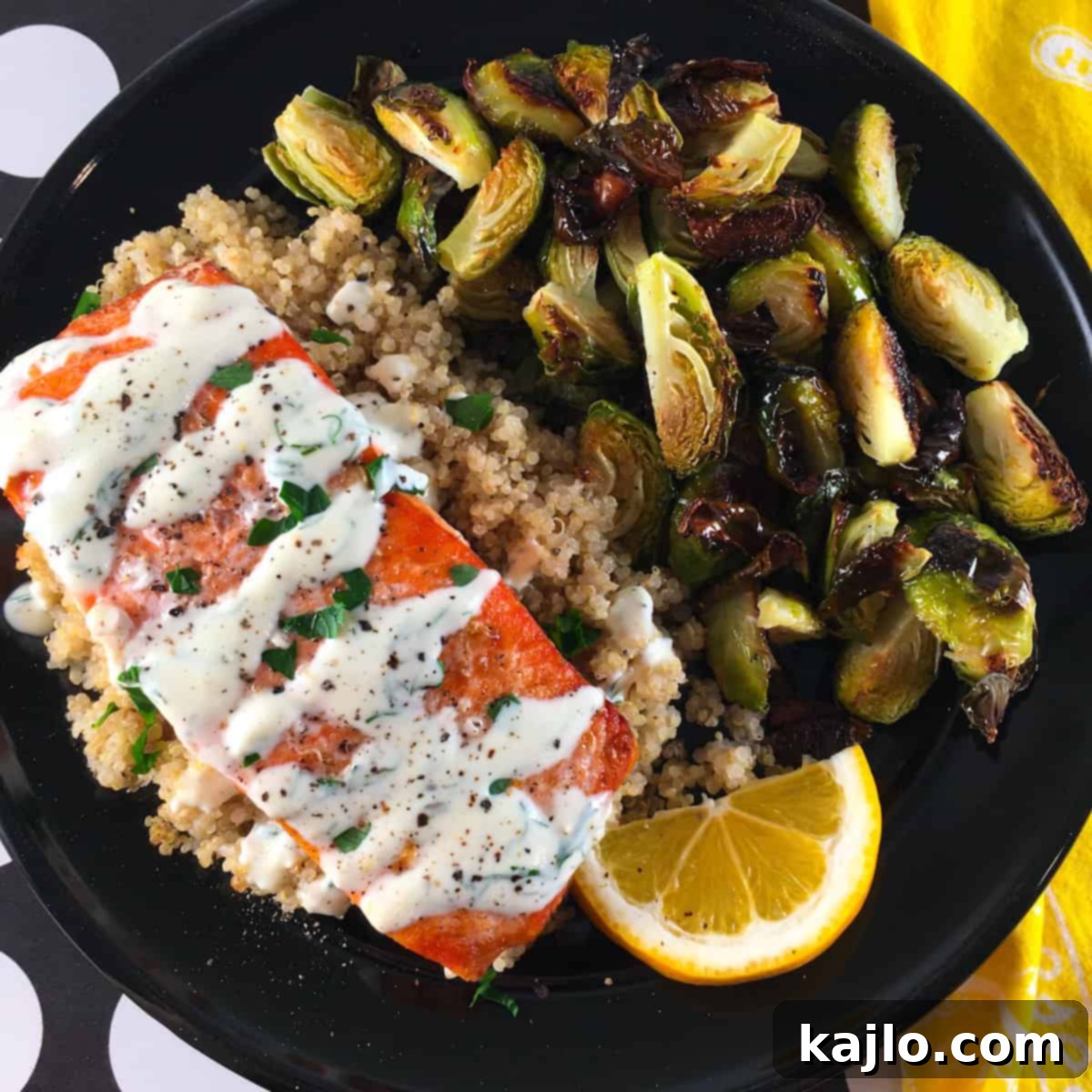
🧂 Elevate Your Dish: Alternative Salmon Seasonings and Sauces
While our lemon cream sauce is undeniably delicious, there’s a vast array of other flavor profiles to explore for your air-fried salmon. If you’re looking to change things up or prefer options lower in saturated fat than cream-based sauces, consider these fantastic alternatives:
- Garlic Butter: A classic pairing that adds rich, savory depth to the salmon.
- Low-Calorie Teriyaki Sauce: Offers a sweet and savory umami kick, perfect for an Asian-inspired meal.
- Honey Mustard Sauce: A delightful balance of sweet and tangy, enhancing the salmon’s natural richness.
- Everything But the Bagel Seasoning: Provides a savory, nutty, and slightly garlicky crunch for a unique twist.
- Old Bay Seasoning: A robust and classic seafood blend that adds a touch of spice and herbal notes.
- Cajun Spice: For those who enjoy a bit of heat and bold, smoky flavors, Cajun seasoning is an excellent choice.
Frozen Salmon in Air Fryer (Salmon Fillets Recipe)
Learn to make air fryer frozen salmon fillets with an indulgent lemon cream sauce that’s low carb, keto, and gluten free. Only 2.2g net carbs per serving!
Author: Summer Yule
Cook Time: 15 minutes
Total Time: 15 minutes
Course: Dinner
Cuisine: Mediterranean
Servings: 2
Calories: 432 kcal
Ingredients
- 12 ounces frozen salmon (340 grams; two fillets with skin, do not thaw)
- Cooking oil spray
- 1 tablespoon olive oil, divided
- 3 tablespoons heavy cream
- 3 tablespoons sour cream
- ½ tablespoon lemon juice, fresh squeezed (from Meyer lemons, if possible)
- ½ teaspoon lemon zest
- Salt and pepper, to taste
- ½ tablespoon fresh dill
Instructions
- Important! For best results, use boneless salmon fillets that are about ½-inch thick (1.27 cm) and are a uniform thickness.
- Preheat air fryer to 390°F (199°C) for 5 minutes.
- Mist a hot air fryer tray with oil spray and put the salmon skin side down on the tray. Use the pastry brush to brush the tops of the salmon with ½ tablespoon of the olive oil. Place the tray in the top rack position of the air fryer.
- Air fry for 14-16 minutes at 390°F (199°C). Flip the salmon about halfway through cooking time (after 8 minutes) and brush with the rest of the olive oil. The skin will get nice and crisp!
- Check your salmon fillets with a meat thermometer to make sure they reached a safe minimum internal temp of 145°F (63°C).
- To make the lemon cream sauce, whisk the heavy cream, sour cream, lemon juice, lemon zest, salt, and pepper over medium heat until just heated with a smooth consistency. (Do not boil!) Whisk in the fresh dill and set the sauce aside, keeping warm.
- To serve, drizzle the lemon cream sauce over the air-fried salmon. Enjoy!
How to Oven Bake Fresh Salmon
- Preheat oven to 400°F (200°C).
- Put fresh salmon in a metal baking pan and bake on a rack ⅓ from the top of the oven for 10 minutes.
- Check salmon using a meat thermometer to ensure it reached a safe minimum internal temp of 145°F (63°C). Extend cooking time if needed.
- Make lemon cream sauce as directed above. Serve oven baked salmon drizzled with lemon cream sauce.
Equipment
- Air Fryer
- Silicone Pastry Brush
- Kitchen Thermometer
Expert Tips from Dietitian Summer Yule
This is a level 2 recipe (transition or weight maintenance). Frozen salmon is about as healthy as fresh, making this a nice, easy way to get more seafood in. If you want to lighten up this meal because you have a weight loss goal, here are some options:
- Make it lower fat: Skip the lemon cream sauce (this knocks off about 125 calories per serving).
- Make it low carb: Serve the meal with non-starchy vegetables, avoiding grains or starchy vegetables.
There are approximately 150-200 calories per ¼ cup of dry rice, quinoa, etc. (which yields around ¾ cup cooked). The lower-carb option may also be the lower-calorie choice, depending on the specific sides you select. The “right” approach ultimately depends on your individual health goals and the dietary pattern you find most satisfying and sustainable.
The debate between low-fat and low-carb diets for weight loss is ongoing, but the most critical factor is adherence. If a person cannot consistently stick to a particular eating style, that approach will not be effective for them long-term.
Mainstream health organizations often recommend the lower-fat option for “heart-healthy” eating. Skipping the cream sauce significantly reduces the saturated fat content in this dish, while serving with whole grains can help retain more dietary fiber.
If you find fiber-rich foods more satiating than added fats, the low-fat option might be better for you. It’s also the preferred choice if you are actively trying to decrease your saturated fat intake.
Remember that salmon is naturally a fatty fish, so even without the cream sauce, this dish is lower in fat but not fat-free. Some fat is essential in any diet, regardless of your dietary preferences. The goal should never be a zero-fat intake.
Nutrition information is for one serving and includes the lemon cream sauce.
Nutrition Info Disclaimer
All recipes on this website may or may not be appropriate for you, depending on your medical needs and personal preferences. Consult with a registered dietitian or your physician if you need help determining the dietary pattern that may be best for you.
The nutrition information is an estimate provided as a courtesy. It will differ depending on the specific brands and ingredients that you use. Calorie information on food labels may be inaccurate, so please don’t sweat the numbers too much.
“To taste” means to your preferences, which may have to be visual to follow food safety rules. Please don’t eat undercooked food.
Nutrition
- Calories: 432 kcal
- Carbohydrates: 2.4 g
- Protein: 38.5 g
- Fat: 30.3 g
- Saturated Fat: 11.1 g
- Fiber: 0.2 g
- Vitamin A: 17% DV
- Vitamin C: 12.5% DV
- Calcium: 11.7% DV
- Iron: 8.6% DV
Keywords
air fried frozen salmon, air fry frozen salmon, air fryer frozen salmon, air fryer frozen salmon fillets, air fryer frozen salmon recipe, air frying frozen salmon, frozen salmon air fryer, frozen salmon in air fryer, lemon cream sauce, make frozen salmon in air fryer
❓ Frequently Asked Questions (FAQs)
How to know when salmon is done cooking?
Properly cooked salmon will appear opaque throughout and flake easily when tested with a fork. While color can be an indicator, it’s not the most reliable method for determining doneness in fish. The most accurate way to ensure your salmon is cooked through and safe to eat is by checking its internal temperature. Insert a meat thermometer into the thickest part of the fish; it should register at least 145°F (63°C).
Can you cook frozen salmon in the oven?
Yes, absolutely! You can indeed bake frozen salmon in a conventional oven. To prevent it from drying out, particularly when cooking from frozen, it’s often beneficial to bake it in a flavorful sauce or with a moist topping. Many resources, such as ButcherBox, provide excellent directions for cooking frozen salmon in the oven, offering various techniques to achieve a moist and tender result.
How to reheat salmon in the air fryer?
Reheating cooked salmon can sometimes be tricky, as there’s a risk of drying it out further. To gently warm previously cooked salmon in the air fryer, we recommend setting your air fryer to a lower temperature, around 350°F (175°C), and reheating for a short duration of 3-4 minutes. Keep a close eye on it to prevent overcooking, ensuring it’s just heated through and remains tender.
How to cook frozen marinated salmon in air fryer?
Cooking frozen marinated salmon in an air fryer requires a slightly modified approach. First, air fry the frozen salmon, without marinade, in a preheated air fryer at 390°F (199°C) for approximately 8 minutes. This initial cooking phase helps to partially thaw and cook the fish. After this period, remove the salmon, brush your desired marinade generously onto the fillets, then return them to the air fryer and continue cooking for another 8 minutes, or until the salmon reaches the safe internal temperature of 145°F (63°C). Always remember that cooking times can vary depending on the thickness of your fish and the specific brand of your air fryer.
How to prevent the white stuff from oozing out of salmon when you cook it?
The “white stuff” that sometimes appears on cooked salmon is a harmless protein called albumin. It’s naturally present in the fish and coagulates when heated, resembling cooked egg whites. While it’s completely safe to eat, you can minimize its appearance by not overcooking the salmon and by cooking it more slowly at a slightly lower temperature if possible. However, you may not be able to eliminate it entirely. If its appearance bothers you, you can simply wipe it off before serving.
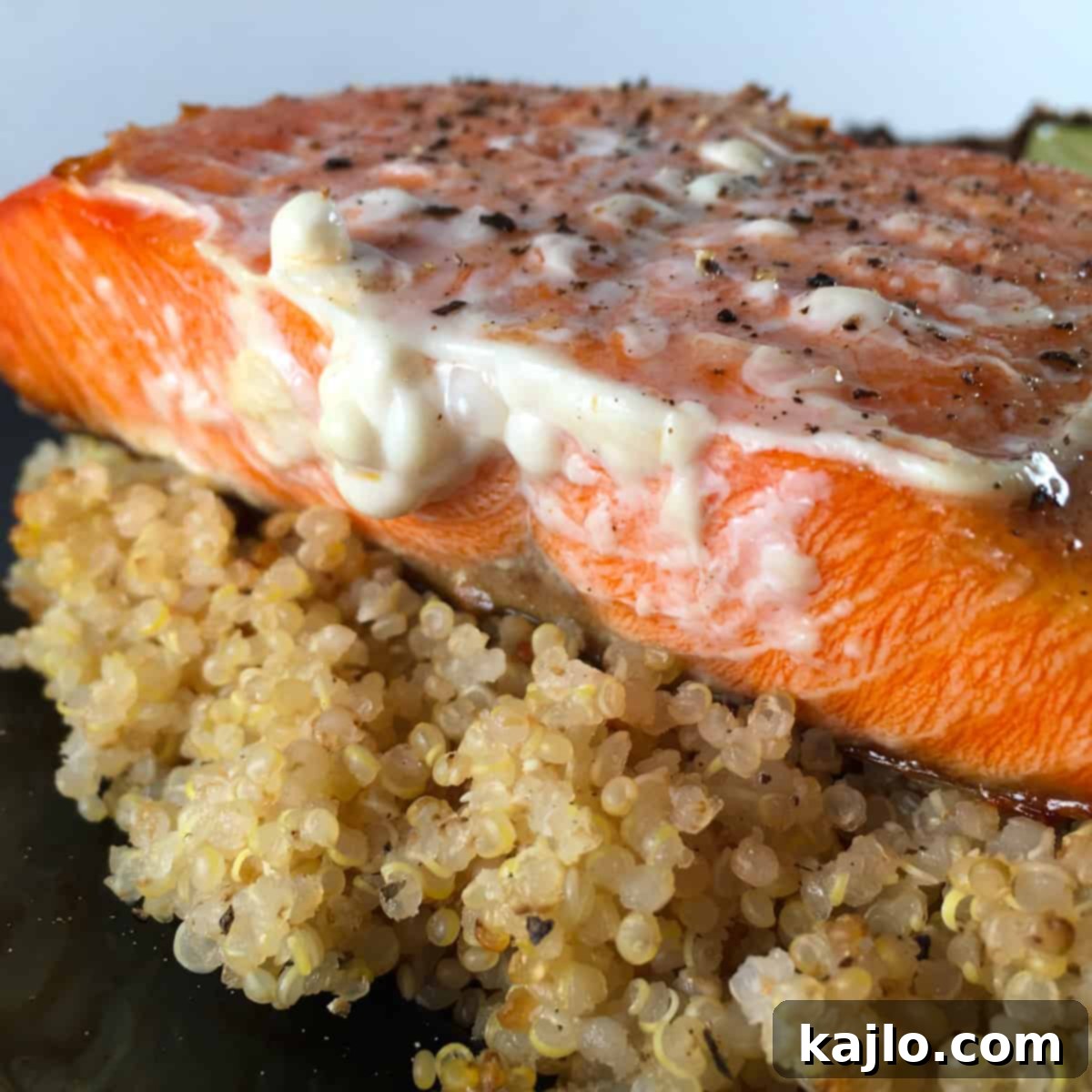
👩🏻🍳 Explore More Air Fryer Recipes for Frozen Seafood
Loved this convenient frozen salmon recipe? If you’re eager for more brilliant ideas for cooking seafood in your air fryer, be sure to check out these fantastic air fryer frozen seafood recipes. They offer similar ease and delicious results:
- Frozen Fish in the Air Fryer: Perfect for breaded fish fillets, ensuring a crispy exterior.
- Air Fryer Tilapia (Frozen or Fresh): A quick and healthy way to prepare this mild white fish.
- Frozen Shrimp in the Air Fryer: Get perfectly cooked, juicy shrimp in minutes.
Join our community! Subscribe for all of the latest and greatest recipes, and follow me on Facebook, Pinterest, Instagram, and YouTube!
